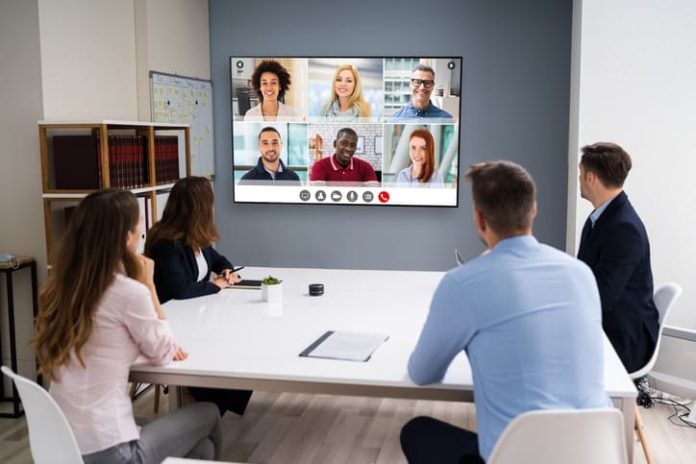Not too long ago, conference calls were plagued by fuzzy connections and disembodied voices, leaving participants yearning for the clarity of face-to-face interaction. Fast forward to today, and we find ourselves amidst a revolution in communication technology, where crystal-clear audio and high-definition video seamlessly unite colleagues across time zones and borders. The evolution of audio-video conferencing solutions serves as a testament to our collective adaptability and innovation. As businesses strive to foster connectivity and productivity in an increasingly dispersed and digital world, these emerging trends are paving the way for a new era of collaboration. Let us take a detailed look into the intricacies of these dynamics to gain a better perspective on these advancements.
AI-Powered Features
AI-powered features have revolutionized the quality of audio-video conferencing solutions by introducing advanced capabilities that enhance the overall meeting experience. The algorithms can identify and suppress background noise, such as keyboard typing, background chatter, or traffic sounds, resulting in clearer audio for participants. Additionally, AI-based translation services can translate conversations into multiple languages, facilitating communication among diverse teams or international participants. AI-driven virtual assistants can analyze participants’ schedules, preferences, and previous interactions to suggest optimal meeting times, agenda items, and action points, streamlining the meeting planning process and maximizing productivity. Moreover, the gesture recognition technology enables participants to interact with virtual whiteboards or share content using hand gestures, creating a more immersive and interactive meeting experience.
Immersive Meeting Experiences
Virtual reality (VR) immersive meeting experiences represent a cutting-edge advancement in audio-video conferencing solutions, offering a transformative approach to remote collaboration. By leveraging VR technology, these solutions provide participants with a sense of presence and immersion beyond traditional video conferencing, thereby enhancing the overall quality of the meeting experiences. The heightened immersion fosters greater participant engagement, leading to more active participation, enhanced focus, and improved overall communication. VR immersive meeting experiences enable participants to communicate nonverbally in a more natural and intuitive manner. Gestures, body language, and facial expressions are captured and conveyed in real time, facilitating more meaningful and nuanced interactions. Whether it’s hosting virtual conferences, training sessions, or product demonstrations, VR immersive meeting experiences create memorable experiences that leave a lasting impression on attendees. In conjunction, VR technology enables more equitable participation in meetings and events due to the immersive experiences that transcend physical limitations.
Enhanced Security Features
Enhanced security features play a crucial role in improving the quality of audio-video conferencing solutions by safeguarding sensitive information, ensuring privacy, and maintaining the integrity of communication channels. Enhanced security features, including end-to-end encryption and secure data transmission protocols, help safeguard against potential data breaches or leaks, thereby preserving the confidentiality and integrity of sensitive information exchanged during meetings. By implementing robust security measures and transparent privacy practices, conferencing providers can instill confidence among users, reassuring them that their sensitive information is protected and their privacy is respected. This, in turn, enhances user satisfaction and promotes broader adoption of conferencing solutions within organizations. Security compliance with authorized regulations mitigates legal risks and fosters trust and confidence among stakeholders.
Mobile Optimization
Mobile optimization is a key component in enhancing the quality of audio-video conferencing solutions by addressing the unique needs and challenges of users who rely on smartphones and tablets for communication and collaboration. Mobile-optimized interfaces are designed to provide an intuitive and seamless user experience tailored specifically for smaller screens and touch-based interactions, ensuring that participants can easily navigate the conferencing app, join meetings, and access essential features. Conferencing apps optimized for mobile devices prioritize power efficiency to minimize battery consumption and extend device battery life during prolonged meetings or calls. The optimization process also ensures compatibility with a wide range of mobile devices, operating systems, and screen sizes, allowing users to access the conferencing solution seamlessly regardless of their device preferences.
Improved AV quality
Improved audio-video (AV) quality represents a significant development in audio-video conferencing solutions, revolutionizing how individuals and organizations communicate and collaborate. High-definition video ensures that facial expressions, body language, and visual presentations are conveyed accurately, fostering better engagement and understanding among participants. Advanced AV solutions leverage optimized network protocols, adaptive bitrate streaming, and error correction techniques to minimize latency and packet loss, ensuring smooth and uninterrupted video and audio transmission even over unreliable networks. AV conferencing solutions deliver optimal performance across diverse environments by dynamically adjusting compression levels based on network conditions and device capabilities.
Hybrid Workforce Support
Advanced audio-video conferencing solutions enable remote employees to seamlessly participate in meetings and collaborate with their in-office counterparts. High-definition video and crystal-clear audio facilitate effective communication, ensuring remote workers feel engaged and included in discussions and decision-making processes. AV solutions offer a range of meeting formats, including virtual meetings, conference calls, and webinars, allowing teams to collaborate effectively regardless of their physical location. Virtual meeting spaces and digital collaboration platforms are becoming increasingly sophisticated, offering features such as virtual whiteboards, screen sharing, and real-time document editing. These tools replicate the experience of in-person meetings, enabling hybrid teams to brainstorm ideas, collaborate on projects, and share information as if they were in the same physical space. Virtual meeting spaces and digital collaboration platforms offer tools and gadgets that replicate the experience of in-person meetings, enabling hybrid teams to brainstorm ideas, collaborate on projects, and share information as if they were in the same physical space. Furthermore, audio-video conferencing solutions promote employee well-being and work-life balance by enabling employees to work remotely without sacrificing connectivity or collaboration. Hybrid work models empower employees to design their work schedules around their personal commitments and preferences, leading to higher job satisfaction and productivity.
Conclusion
As we navigate the latest trends in audio-video conferencing solutions, it’s evident that technology continues to revolutionize how we connect, collaborate, and communicate in today’s dynamic work environment. From the rise of hybrid workforce support to the integration of AI-powered features and the emphasis on security and flexibility, these trends are reshaping the future of remote and hybrid work. By staying abreast of these developments and leveraging innovative solutions, organizations can foster seamless collaboration, enhance productivity, and adapt to the evolving needs of a modern workforce.



































